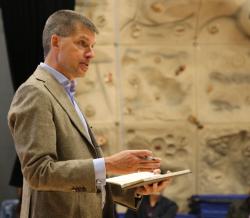
Description
How do buildings make us feel?
How can they make us feel better?
Importantly, how can they enhance our performance, and create the condition in which we thrive?
Through research in the emerging intersection of neuroscience and architecture, Tye Farrow explores how our mind, and its various sensory systems, interacts with our built environment to enhance or harm health and well-being.
Although the biological brain is physically housed in the skull, recent research reveals that the mind, the brain’s operating system, extends through and beyond the body to engage with our surroundings. This raises urgent questions about the role of architecture and placemaking in creating mind health.
Tye bridges the gap in knowledge between the therapeutic medical world and the design community to reveal how the intentional shaping of our environment can support our physical and neurological health and well-being. He draws on research in fields of sensory integration theory, environmental psychology, occupational psychology, human factor psychology, experimental psychology, cognitive neuroscience, and attention restoration theory, as well as related non-clinical areas of health enhancement that include biophilia, neurodiversity, sensory impact, neuroaesthetics, neuroarts, neurophenomenology, neuro wellness, environmental neuroscience, and neurourbanism.
Tye explores recent discoveries in cognitive psychology (the science of the mind) and neuroscience (the science of the brain) on how we form salutogenic, health-giving, person-to-place relationships that are similar to healthy and meaningful person-to-person relationships.?
Through the study and application of environmental enrichment, Tye shows how we can intentionally design our environments to make them more generous and offer affordances that help us in our daily life. This not only reduces environmental damage but also enhances physical, societal, and mind health.
Tye Farrow offers an engaging and accessible way forward in how we can construct health through specific, measurable design qualities and characteristics which enhance human performance in the cities we live, the homes we dwell, the places we learn, and the spaces we heal.
Learning Outcomes
At the conclusion of the presentation attendees will:
- Describe how architecture and place making can influence mind health.
- Explain how to shape an environment to support health and wellbeing.
- Recognise how research into cognitive psychology and neuroscience is informing design.
- Better communicate the benefits of biophilic design to clients and stakeholders.
- Identify some of the measurable design qualities and characteristics which enhance human performance.
Speaker

TYE FARROW
Senior Partner, Farrow Partners Architects
FRAIC, B.Arch., M.Arch.U.D., M.Neuro.Appl.Arch.Des., OAA, MAIBC, AIA Assoc, LEED AP
Working at the intersection of architecture and neuroscience, Tye Farrow is a world-recognized pioneer tackling how what we create either gives or cause health. With award-winning projects around the globe that enact salutogenic design - design that actively incites health - he is the first Canadian architect to have earned a Master of Neuroscience Applied to Architecture (University of Venice IUAV) and has a Master of Architecture in Urban Design (Harvard University), and a Bachelor of Architecture degree (University of Toronto).
Tye is a sought-after speaker who has presented to respected organizations and universities in over forty cities on six continents, including the Salk Institute, The Johns Hopkins University School of Medicine, Mayo Clinic and The Cleveland Clinic, and has been called a global leader making “a significant contribution to health and humanity through the medium of architecture” (Stockholm World Design & Health Congress) and “one of the world's most prominent practitioners of, and advocates for, human-built environments that enrich our lives through neuroarts choices” (Susan Magseman, Founder and Director, International Arts + Mind Lab, Johns Hopkins Medical School, “Your Brain on Art”). Davide Ruzzon, Director of the University of Venice IUAV, Master of Neuroscience in Architecture, notes:
“Tye Farrow, combines a reinterpretation of Aaron Antonovsky’s salutogenesis with the study of neuroscience, and builds a new theory that proposes architecture as a health-generating system, conceived as a schema of relationships capable of creating psychological, as well as physical and biological well-being.”
In his first book, to be published by University of Toronto Press in the fall of 2023, titled “Constructing Health: An Exploration of Generous Architecture: Through the Neurological, Psychological, and Emotional Benefits of Enriched Environments”, Tye further explores these issues, and how the built environment can be used to create the conditions where we flourish.
Whether it’s a new 32-km mixed-use archipelago park inspired by Vivaldi’s “Four Seasons” to address rising sea levels in Venice; a new cancer centre in Jerusalem under construction that communicates life’s beauty & fragility through a butterfly-like wood structure; Dublin Ireland’s flagship private hospital which communicates Celtic mythology tied to the land; a Toronto education campus that embeds tree-like natural affordances; or a Sechelt BC hospital that reflects First Nations’ notions of generosity; Farrow is “one of nineteen global earth champions and wellness visionaries who are changing what it means to do good” (Hospitality Design).
